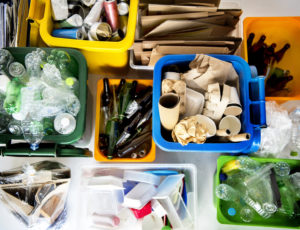
Letter
Adding “Microplastics” to the Candidate Chemical List
SUBMITTED Via CalSafer Online Portal
August 4, 2025
California Department of Toxic Substances Control
Director Katherine Butler
1001 I Street P.O. Box 806
Sacramento, CA 95812
Re: Adding “Microplastics” to the Candidate Chemical List
Consumer Brands Association (Consumer Brands) is appreciative of the opportunity to submit comments regarding the California Department of Toxic Substances Control (DTSC, the Agency) proposed amendment to the Safer Consumer Products Regulations, Adding Microplastics to the Candidate Chemicals List.1
The Consumer Brands Association champions the industry that makes the products you choose and the brands you trust. From household and personal care products to food and beverage products, the consumer-packaged goods (CPG) industry plays a vital role in California, employing 2.6 million people and contributing over $281 billion to the state’s GDP. The CPG industry also plays a crucial role in creating a more sustainable future through its products and has prioritized packaging and recycling innovation. The CPG industry is among the most integral stakeholders in the efforts California is undertaking to improve the environmental management of materials within the state for both the health of consumers and the environment. Consumer Brands and its members are key stewards and funders of California’s extended producer responsibility (EPR) and Truth in Labeling programs, established to improve the recovery and recycling of packaging materials, particularly plastic, within the state.2
Consumer Brands is aligned with DTSC’s overarching mission of managing chemicals such that adverse impacts on human health and the environment are mitigated. The industry has also been a proactive partner in California’s ongoing efforts to recover and recycle plastic materials to avoid plastic waste, through voluntary industry commitments and direct engagement with statewide recycling and consumer education programs.3 However, the proposed wide-sweeping inclusion of “microplastics” on the Candidate Chemicals List exceeds DTSC’s authority, threatens to compromise the success of both of California’s circularity programs, and villainizes essential goods. Consumer Brands recommends DTSC prioritize identifying and validating high-risk chemicals through evidence-based research, rather than acting outside the scope of its authority and adopting an indiscriminate definition which can encompass nearly all consumer products.
DTSC Lacks Authority to List “Microplastics” under the Safer Consumer Products Framework as They are Not a “Chemical”
DTSC’s approach to collectively regulate the entire broad “microplastics” category, rather than “a substance of a particular molecular identity,” is unprecedented and exceeds DTSC’s authority to list Candidate Chemicals under the Safer Consumer Products program.
The Safer Consumer Products framework, established by the Green Chemistry law, sets forth specific criteria and processes for listing chemicals and regulating products.4 “Microplastics” are not a single, identifiable “substance of a particular molecular identity” and are therefore not a “chemical” that can be included on the Candidate Chemicals List.5 In order to constitute a “chemical”, a substance must have a “particular molecular identity,” where “molecular identity” is defined to include all of the following properties: agglomeration state; bulk density; chemical composition, including surface coating; crystal structure; dispersibility; molecular structure; particle density; particle size, size distribution, and surface area; physical form and shape, at room temperature and pressure; physiochemical properties; porosity; solubility in water and biologically relevant fluids; surface charge, and surface reactivity.6
DTSC does not propose to list any specific “chemical,” but instead asserts that “microplastics” “collectively meet the definition of ‘chemical’” and broadly defines “microplastics” as plastics that do not to exceed a certain size. Plastics and microplastics, however, can encompass a broad range of materials of differing molecular identities. A plastic particle could be polyethylene, polystyrene, nylon, or any number of polymer types – each with unique molecular identities. Microplastic particles can also have different particle sizes, up to specified maximum dimensions. DTSC’s proposed definition of microplastics would encompass particles of varying sizes and also smaller particles, such as what are generally considered to be nanoplastics. DTSC, however, must list a “chemical” which involves consideration of a substance’s specific properties, including particle size and surface area.7 The statute and regulations governing the Safer Consumer Products Program authorize DTSC to list only a “chemical” and do not provide DTSC the authority to collectively list a broad material category of plastics that have varying sizes and molecular identities. Specification of a “chemical” is essential for regulated entities and necessary to complete an Alternatives Analysis that fulfills the Safer Consumer Products regulatory requirements should DTSC identify any Priority Products containing a “chemical of concern.”
Overly Broad Definition of “Microplastics” Encompasses Virtually All Plastic Products
Microplastics as proposed to be defined8 do not qualify as a “chemical” as defined in 22 CCR § 69501.1(a)(20)(A), because they lack a “particular molecular identity,” as that defined in §3 69501.1(a)(20)(B). As shown by actions of the U.S. Environmental Protection Agency under the Toxic Substances Control Act using virtually identical definitions, microplastics are mixtures of mixtures, not a single chemical. As they are not a “chemical,” they cannot be listed as a candidate chemical.
Even if DTSC could list a broad material category of plastics as a “chemical,” DTSC’s Technical Document fails to adequately assess the hazard traits and/or or environmental or toxicological endpoints for the entire category of plastics that could fit within DTSC’s proposed definition of “microplastics.” The Technical Document supporting the addition of microplastics to the Candidate Chemical List is extremely broad identifying vague conclusions about the broad category of constituents described as microplastics in attempt to describe Adverse Impacts covered under subdivision (b)(1)(A). This vague, conclusory analysis is insufficient evidence to support the conclusion that these materials are hazardous or toxic. Further, it does not appear that DTSC considered any component of (b)(1)(B), which the Agency “shall” consider per the regulations. These are just two examples of DTSC’s failure to follow its own regulatory framework in adding microplastics to the Candidate Chemical List. DTSC’s authority to revise the Candidate Chemicals List is limited to identifying “chemicals that exhibit one or more hazard traits and/or environmental or toxicological endpoints.”9 The proposed definition of “microplastics,” however, would capture an enormous range of materials and products, rather than a singular chemical. The proposed breadth of “microplastics” mislabels consumer safety features as hazardous or toxic, undermining consumer confidence in essential products. Consumer Brands advises DTSC to narrow this definition to focus on specific, high-risk microplastic sources rather than an all-encompassing category.
“’Microplastics’ are plastics that are less than 5 millimeters (mm) in their longest dimension, inclusive of those materials that are intentionally manufactured at those dimensions or are generated by the fragmentation of larger plastics.”10
All plastics are technically susceptible to fragmentation; the proposed definition encapsulates any good, whether a product, component, or packaging material which includes plastic.11 “Microplastics” as defined would include durable goods, automobiles, textiles, electronics, and nearly every item in the grocery store. This definition takes a one-size-fits-all approach that disregards critical differences and risks misclassifying countless everyday consumer goods as containing a candidate chemical.
For example, personal care items like hand soaps and wet wipes often use small polymer ingredients or are encased in plastic containers; over-the-counter medicines and hygiene products rely on sanitary plastic packaging and safety seals. Basic household staples, such as a paper products, are wrapped in thin plastic film, cleaning supplies in plastic bottles, or common food items in plastic pouches. All of these materials could be swept into the “microplastics” category. The proposal would categorize a huge swath of essential consumer goods as potentially hazardous, stigmatizing these products in the eyes of consumers and regulators.
The CPG industry has a vested priority in consumer safety; Consumer Brands members use plastic components to protect consumers and products. Plastic components are incorporated to create tamper-proof and child lock seals, plastic films prevent products from harmful external contaminants, and plastic packaging preserves the shelf stability of food items to prevent food spoilage and product degradation. Plastic in packaging is necessary to ensure the goods that consumers purchase is safe for consumption and use.
Incorporating nearly every product containing or packaged in plastic on the market into the Candidate Chemicals List for potential “chemical of concern” designation sends a misleading message to consumers that the product is inherently hazardous or toxic, eroding consumer trust in everyday items. It also disregards the fact that plastic packaging often serves vital public health functions, protecting consumer products from contaminants and malintent.
Persuasive insights on microplastic characteristics can be gleaned from federal authorities, which have declined to proceed in the unprecedented matter that DTSC contemplates. For instance, the United States Food and Drug Administration (FDA) has set forth that the “presence of environmentally derived microplastics and nanoplastics in food alone does not indicate a risk and does not violate FDA regulations unless it creates a health concern. While many studies have reported the presence of microplastics in several foods, including salt, seafood, sugar, beer, bottled water, honey, milk, and tea, current scientific evidence does not demonstrate that the levels of microplastics or nanoplastics detected in foods pose a risk to human health.” 12 Moreover, the FDA has noted that “There is not sufficient scientific evidence to show that microplastics and nanoplastics from plastic food packaging migrate into foods and beverages” and “because there are no standardized methods for how to detect, quantify, or characterize microplastics and nanoplastics, many of the scientific studies have used methods of variable, questionable, and/or limited accuracy and specificity.”13
Definition Poses Disproportionate Compliance Burdens & Risks to Consumer Access
The magnitude of compliance obligations and costs that the proposed definition predicates would be detrimental to businesses in California, as well as create product scarcity risks.
Under the Safer Consumer Products framework, if a product-chemical combination is listed as a Priority Product, responsible entities must notify DTSC, perform an Alternatives Analysis evaluating safer alternatives, and potentially reformulate or cease sales if no feasible alternative exists. Requiring an Alternatives Analysis for even a single product is a complex, resource-intensive process; requiring Alternatives Analyses for hundreds or thousands of products is an unprecedented burden on industries and businesses. For many companies in the food, personal care, and household goods sectors, the breadth of this definition could require evaluating nearly every product line sold in California. The compliance costs of conducting Alternatives Analyses at such a scale would be staggering, diverting resources from ongoing sustainability innovation and existing consumer protection programs without commensurate benefits to health or the environment.
Additionally, this proposal creates tangible risk for forced reformulation or removal of products from the California market. In cases where a plastic-free alternative design may compromise product efficacy or safety, companies could be forced to eliminate product sales within the state.
Californians could see reduced availability of everyday necessities if manufacturers withdraw products due to onerous compliance demands or prohibition of plastic materials. For example, if personal hygiene products are deemed Priority Products with no immediately viable alternative materials that meet rigorous industry consumer safety requirements, the result could be empty shelves or higher prices for essential goods. Even critical health and sanitation products (i.e. disinfectant wipes, medical devices, over the counter drugs) could face disruption. This has significant implications for product access and consumer safety.
In addition to hefty compliance costs and market impacts, the addition of “microplastics” introduces litigation risks. By labeling “microplastics” and therefore, the majority of consumer products, as potential chemicals of concern DTSC may inadvertently expose Californian businesses to legal action without sufficient factual or scientific bases. Companies could find themselves facing costly lawsuits for the use of plastic materials, despite operating in compliance with all existing laws, utilizing packaging which protects consumer safety, and innovating to improve the sustainability of products.
As proposed, businesses may be subject to enormous compliance costs and legal uncertainty, while consumers will likely face reduced choice, higher costs, or even loss of access to essential products. Consumer Brands advises DTSC that a targeted approach, focusing on specific high-risk chemicals clearly identified by scientific evidence, would better insulate consumers and industry from sweeping negative outcomes.
Additionally, by definitionally relying on size, if an Alternatives Analysis is ultimately conducted on “Priority Product” microplastic, the size of the microplastic would presumably drive the development of an alternative. It could be conceived that an appropriate alternative could be a plastic or other material formulation that may be chemically toxic but is not intentionally manufactured or does not break down into less than 5 millimeters (mm). This possible outcome seems counter to the goals of the Safer Consumer Products Program.
Inclusion Conflicts with California’s Circularity Programs & Investments
The timing and scope of the proposed inclusion is also fundamentally misaligned with California’s own landmark recycling and circular economy programs. These programs are designed to reduce plastic pollution through improved materials management, recycling, and consumer engagement. By effectively declaring all plastics to be hazardous or toxic, DTSC will undermine these goals and waste substantial resources invested within the programs.
SB 54 (Plastic Pollution Prevention and Packaging Producer Responsibility Act) established a comprehensive, statewide recycling framework funded by producers of goods sold within California. In addition to the establishment of ambitious recycling targets, the law mandates packaging sustainability advancements such as increased recyclability, source reduction, and composting requirements. The program will necessitate an estimated two trillion-dollar investment from producer companies and their representative Producer Responsibility Organization to achieve these goals. Consumer Brands and its members are key stakeholders in the SB 54 program, redesigning packaging for recyclability, funding collection and recycling, and collaborating with the California Department of Resources Recycling and Recovery (CalRecycle) to improve consumer participation.
Pouring substantial resources into a statewide recycling overhaul and then simultaneously regulating the majority of the products within the program as hazardous or toxic, is counterproductive and confusing to consumers. This may disincentivize consumer participation in the recycling system and discourage consumer purchasing of recyclable or circular plastic materials, directly undercutting the sustainability goals established by SB 54.
California is also implementing SB 343 (Truth in Labeling) to ensure consumers receive clear, accurate information on what products and packaging are recyclable. SB 343 restricts the use of recycling labels unless stringent sustainability criteria are met. The program is intended to increase clarity for consumer participation and confidence in the statewide recycling system. Listing “microplastics” as a candidate chemical directly muddles the consumer understanding and informed participation in the recycling system SB 343 seeks to create, increasing risk of cynicism around the effectiveness of plastic recycling and safety of plastic packaging and materials.
Fundamentally, both SB 343 and SB 54 were established to divert materials, particularly plastic packaging, from landfills and the environment; DTSC should avoid taking regulatory action which contradicts or harms the success of programs intended to support the environmental and safe management of materials. The Agency should look instead for opportunities to align its actions with the comprehensive sustainability goals these programs create.
Definition Breadth May Cause Consumer Fatigue & Indifference
Labeling essentially all plastics as potentially hazardous or toxic may erode consumer confidence in DTSC actions and designations. This could invite public skepticism about the seriousness and proportionality of DTSC actions.
Overuse or redundancy in warning labels can diminish their effectiveness. Repeated exposure to warnings across a wide range of products is likely to desensitize consumers, leading to indifference rather than informed behavior. The proposed inclusion of “microplastics” on the Candidate Chemicals List, ultimately encompassing a diverse and extensive array of consumer goods, risks diluting the impact of truly hazardous substance warnings and may erode consumer trust in safer consumer products regulatory systems.
Proposed Definition Undermines Industry-led Sustainability Initiatives
Consumer Brands Association’s member companies are constantly innovating to develop packaging and products which minimize environmental impact. For example, a cleaning product company achieved zero-waste-to-landfill for thirty of its sites. A coffee company reached 90% recyclability or composability across its product portfolio. Another Consumer Brands member achieved 79% recyclable or reusable packaging across its sales.14
Many plastic packaging formats encompassed within “microplastics” have been designed for circularity, whether through lightweighting to reduce the amount of plastic used, increased material recyclability, incorporation of recycled content, or through other innovations. The proposed definition of “microplastics” contains no distinctions, implicating products that are recyclable, compostable, made with recycled content, and critical for health and safety.15
This unfairly penalizes manufacturers that have made significant progress in improving the sustainability of plastic products and packaging by lumping these products in with non-circular plastic materials. The proposed definition creates an absurd scenario in which a sustainable package containing recycled plastic content is regulated as a potentially hazardous or toxic substance by DTSC, while a non-sustainable material avoids being deemed environmentally unsafe. Consumer Brands urges DTSC to align its approach with the broader statewide strategy of regulating plastic as materials which should be part of a circular recycling and recovery system to avoid disincentivizing sustainable packaging innovation.
* * *
The Consumer Brands Association supports the intended outcome of promoting environmentally responsible and safe materials management. In addition to the CPG industry’s commitment to shaping effective recycling programs in California to divert plastic materials from the environment, Consumer Brands and the CPG industry are actively pursuing these goals through voluntary, industry-led initiatives. Consumer Brands advises DTSC to avoid actions which would compromise the success of existing sustainability programs or misrepresent essential, safe consumer products to the public. Thank you again for the opportunity to comment on the proposed inclusion. Please do not hesitate to contact me at [email protected] if you have any questions regarding this request.
Sincerely,
Erin Raden Senior Director, State Affairs Consumer Brands Association


